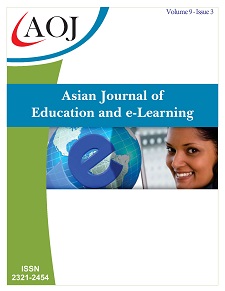Teaching and Learning in Classroom Based on Design Thinking
DOI:
https://doi.org/10.24203/ajeel.v9i3.6627Keywords:
Design Thinking Teaching LearningAbstract
To address complex problems, design thinking is highly valuable because it offer a mindset and collection of strategies to systematically gather, analyze, and utilize data to inform novel solutions. As a problem-solving framework, Design thinking can be applied in teaching and learning in classroom. It offers a diverse set of adaptable problem-solving and idea generation processes that can help students to learn how to learn and develop a more creative mindset, and foster interdisciplinary exploration.
References
Adams C, Nash J B . Exploring Design Thinking Practices in Evaluation. 2016.
Beligatamulla G . Design thinking for business and entrepreneurship: accelerating innovation in higher education in Sri Lanka[C]// International Conference on Business Research. 2018.
David, Dunne, Roger, et al. Design Thinking and How It Will Change Management Education: An Interview and Discussion[J]. Academy of Management Learning & Education, 2006.
Educational Researcher, 28(7), 4-14. https://doi.org/10.3102/0013189X028007004
Fisher W P , Oon P T , Benson S . Applying Design Thinking to systemic problems in educational assessment information management[J]. Journal of Physics Conference, 2018, 1044.
Grubb R , Reich J , Huttner-Loan L , et al. Design Thinking for Leading and Learning in Review. 2017.
Kernbach S , Nabergoj A S . Visual Design Thinking: Understanding the Role of Knowledge Visualization in the Design Thinking Process[C]// International Conference Information Visualisation. IEEE Computer Society, 2018.
Martin, Roger, L. The Design of Business: Why Design Thinking Is the Next Competitive Advantage.[J]. Harvard Business School Press Books, 2009.
Mosley G, Wright N, Wrigley C . Facilitating design thinking: A comparison of design expertise[J]. Thinking Skills & Creativity, 2018:S1871187117302249.
Schoenfeld, A. (1999). Looking toward the 21st century: Challenges of educational theory and practice.
Taylor J. Combining design thinking and "wordless picturebooks" for discussion of social issues. 2018.
Wong Y L, Wong B . Design Thinking for Education[M]. 2019.
XinKai Yang, Thinking and Exploration of Curriculum Teaching Based on Design Thinking Framework[J]. Advances in Education, 2017, 007(006):P.376-380.
Downloads
Published
Issue
Section
License
Copyright (c) 2021 Min Li

This work is licensed under a Creative Commons Attribution-NonCommercial 4.0 International License.
- Papers must be submitted on the understanding that they have not been published elsewhere (except in the form of an abstract or as part of a published lecture, review, or thesis) and are not currently under consideration by another journal published by any other publisher.
- It is also the authors responsibility to ensure that the articles emanating from a particular source are submitted with the necessary approval.
- The authors warrant that the paper is original and that he/she is the author of the paper, except for material that is clearly identified as to its original source, with permission notices from the copyright owners where required.
- The authors ensure that all the references carefully and they are accurate in the text as well as in the list of references (and vice versa).
- Authors retain copyright and grant the journal right of first publication with the work simultaneously licensed under a Attribution-NonCommercial 4.0 International that allows others to share the work with an acknowledgement of the work's authorship and initial publication in this journal.
- Authors are able to enter into separate, additional contractual arrangements for the non-exclusive distribution of the journal's published version of the work (e.g., post it to an institutional repository or publish it in a book), with an acknowledgement of its initial publication in this journal.
- Authors are permitted and encouraged to post their work online (e.g., in institutional repositories or on their website) prior to and during the submission process, as it can lead to productive exchanges, as well as earlier and greater citation of published work (See The Effect of Open Access).
- The journal/publisher is not responsible for subsequent uses of the work. It is the author's responsibility to bring an infringement action if so desired by the author.


